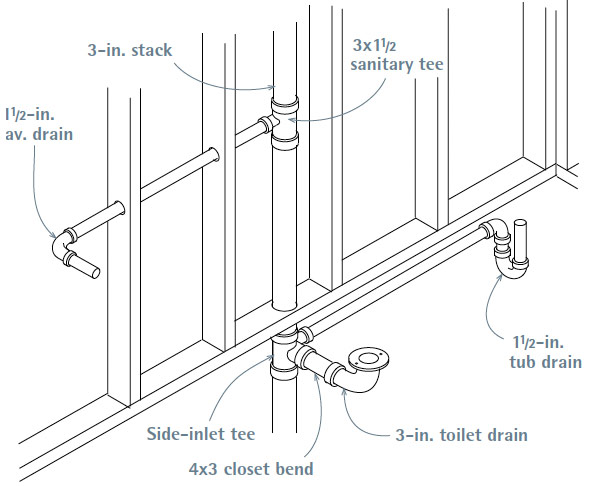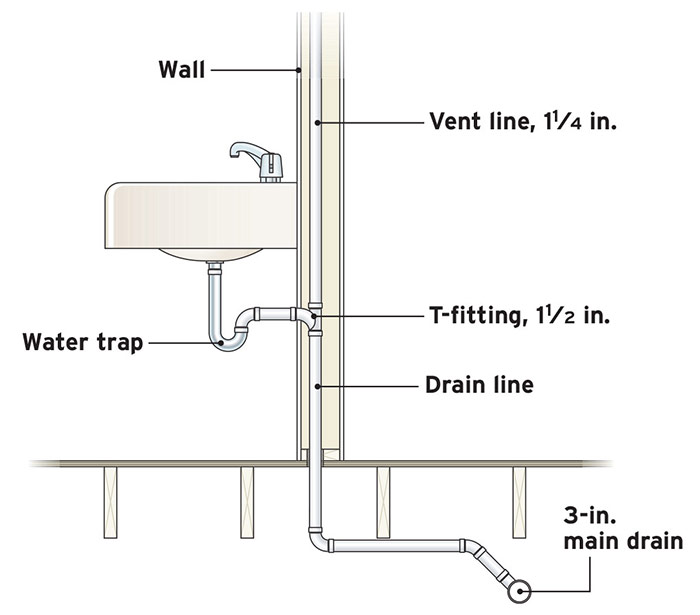Grasping The Value of Adequate Ventilation in Plumbing Systems
Grasping The Value of Adequate Ventilation in Plumbing Systems
Blog Article
We have stumbled on the article pertaining to What Is A Plumbing Vent & How Do They Work? listed below on the web and felt it made perfect sense to talk about it with you on my blog.

Correct air flow in plumbing systems is typically ignored, yet it is critical for keeping the capability and safety and security of your home's pipes. Air flow helps control atmospheric pressure, avoid the build-up of hazardous gases, and make sure the effective removal of waste. In this guide, we will explore the significance of proper pipes air flow, exactly how it works, and the benefits it gives your pipes system.
Exactly How Air Flow Functions in Plumbing Solutions
Atmospheric Pressure Policy
Proper ventilation maintains well balanced air pressure within the plumbing system. When water moves with pipelines, it displaces air. Without sufficient air flow, this variation can create unfavorable stress, resulting in slow down drains pipes or siphoning of water from catches, which can cause unpleasant odors to permeate right into the home.
Avoiding Drain Gas Accumulation
Among one of the most vital features of plumbing vents is to prevent sewer gases, such as methane and hydrogen sulfide, from gathering within the home. These gases can pose significant health and wellness threats and are very flammable. Vent pipelines permit these gases to escape safely outside.
Aiding in Waste Removal
Ventilation assists in the efficient elimination of wastewater by preventing airlocks in the drainage system. When air can flow openly with the vents, it allows water and waste to move smoothly through the pipelines, minimizing the risk of blockages and backups.
Advantages of Proper Air Flow
Enhanced System Performance
Appropriately aerated plumbing systems run much more successfully, with fewer blockages, faster draining pipes, and much less strain on the pipelines. This performance extends the lifespan of the pipes system.
Improved Air Top Quality
By preventing sewage system gases from entering your home, correct ventilation adds to better interior air quality, making your living setting healthier and a lot more comfortable.
Avoiding Water Damage
Adequate ventilation aids prevent water from being siphoned out of catches, which can lead to drain gases getting in the home and triggering water damage with time.
Steps to Ensure Appropriate Ventilation
Consulting Plumbing Codes
Always seek advice from regional plumbing codes when designing or modifying your pipes system. These codes offer the needed standards for proper venting and guarantee your system satisfies safety requirements.
Regular Inspection and Upkeep
Regular examinations can aid recognize possible ventilation problems before they end up being major issues. Maintenance jobs, such as cleaning up vent pipelines and checking for blockages, are necessary for maintaining the system in good working order.
Professional Installation
For brand-new setups or major modifications, it's a good idea to hire a specialist plumbing. They have the know-how to make certain the ventilation system is appropriately created and mounted according to code.
Recognizing Air Flow in Pipes
Air flow in pipes refers to the network of pipelines that permit air to stream with the drain system. These vents offer several functions, including regulating air pressure within the pipelines, protecting against sewer gases from entering the home, and helping in the smooth flow of wastewater.
Sorts Of Plumbing Vents
Key Heap Vent
The primary pile air vent, additionally known as the air vent pile, is the primary air vent in a pipes system. It prolongs from the major drainpipe line up through the roof covering, allowing gases to leave and fresh air to go into the system.
Branch Vent
Branch vents connect to the main stack air vent and offer private fixtures, such as sinks, toilets, and showers. These vents ensure that each component has appropriate ventilation to function appropriately.
Air Admittance Valve (AAV).
An Air Admission Valve (AAV) is a one-way valve that permits air to get in the pipes system without the demand for a standard vent pipeline expanding via the roof. AAVs are typically utilized in remodellings or locations where setting up a basic air vent is impractical.
Indicators of Poor Ventilation in Plumbing.
Slow Draining Fixtures.
If your sinks, bathtubs, or commodes are draining slowly, maybe a sign of poor air flow. Poor air circulation can create a vacuum impact, making it hard for water to drain pipes correctly.
Gurgling Seems.
Gurgling noises originating from drains pipes are usually an outcome of air being drawn via water catches as a result of adverse stress in the pipelines. This is a clear indication of not enough air flow.
Unpleasant Odors.
Drain odors inside your home are a warning that your pipes system is not appropriately ventilated. This could imply that drain gases are not being adequately aired vent outside, leading to potentially unsafe conditions.
Typical Air Flow Blunders.
Poor Vent Sizing.
Using undersized air vent pipelines can cause bad air flow and stress inequalities in the system. It's vital to utilize vents that meet the details demands of your plumbing system.
Improper Vent Positioning.
Placing vents also far from the components they serve can lower their efficiency. Proper placement guarantees that air can move freely and successfully through the system.
Disregarding Code Needs.
Building codes offer particular standards for pipes ventilation. Disregarding these codes can lead to a system that stops working to work correctly and might lead to costly repairs or carcinogen.
Conclusion.
Proper air flow is an important part of any kind of pipes system, guaranteeing that it works efficiently and securely. By recognizing the importance of ventilation, identifying the indicators of inadequate ventilation, and taking steps to maintain your system, you can protect against pricey problems and safeguard your home's air quality.
4 Things You Should Know About Your Plumbing Vents
What Plumbing Vents Are
Also called a vent stack, a plumbing vent is a vertical pipe attached to your drain line that runs through your roof. The plumbing vent pipe, or plumbing air vent, removes gas and odors from your plumbing system and allows fresh air to enter the pipes, helping the water to flow out of the drain pipes.
What Plumbing Vents Do
Plumbing vents have two basic functions. One of which is to allow unpleasant smelling wastewater and sewer gasses to escape your plumbing system instead of entering your home. Plumbing vent pipes are typically located on roofs, away from windows, to ensure the fumes exit the home completely.
The other function of the plumbing vent is to move fresh air into your plumbing system. This helps move water through every plumbing fixture in your house, like toilets and sink drains. Think of the way in which you need to let a little air into the bottle as you pour soda in order to make the drink flow smoothly.
Different Types of Plumbing Vents
True vent: This is the most common vent option. In simplest terms, a true vent is a vertical pipe attached to your drain line that exits through the roof. They often function as the main vent that other fixtures can connect to. Re-vent pipe or auxiliary vent: Attached to the drain line near specific plumbing fixtures, re-vent pipes run up and over to connect to the main vent. Common vent: Two plumbing fixtures installed on opposite sides of a wall are typically tied into the vent stack using something known as a sanitary cross. Wet vent: This venting option operates as a drain pipe and a vent at the same time. Wet vent drainage systems drain water from one fixture while venting the air from another. Although they’ve been used for over 100 years, wet vent systems have only recently been added to the plumbing code in many areas. If you’re planning on installing one in a bathroom remodel, make sure you check your local code prior to construction. Loop vent: For free-standing fixtures like kitchen island sinks, loop vents are ideal. These vent pipes run under the floor, rise from the P-trap, and create a loop inside the cabinet sink. Air admittance valve: An AAV is a one-way mechanical valve typically installed at the site of the plumbing fixture. AAVs allow venting to occur without having to tie into a larger venting system. They’re ideal for venting fixtures where you aren’t able to easily connect to an existing vent system. Common Plumbing Vent Issues
Although vent pipes typically don’t have water flowing through them, they’re still subject to many typical plumbing issues. For example, clogs are one of the most common problems associated with sewer vent pipes. If your vent pipe gets clogged, all of your plumbing fixtures tied into the vent stack will be affected.
A sink with a slow drain that bubbles and gurgles or a strong sewage smell around your toilet are both indicators that your toilet vent pipe is clogged. Because most vent pipes exit through the roof, old leaves, twigs or even a bird’s nest could be clogging the pipe.
Clogs in your vent pipe system cause a buildup of negative pressure, meaning that water won’t be able to flow out of your home very well. It’s similar to putting your finger over the opening of a straw to trap water inside. When you remove your finger, the water is able to flow out of the straw.
If you suspect you have any blockage in your vent, make sure you have a professional come examine the situation. Left unchecked, a blocked air vent can lead to other costly repairs, like leaks and sediment buildup.
Under Pressure
Pipe vents are essential aspects of a home’s plumbing system. Owning a home means learning about all sorts of things you never put much thought into before. But by understanding as much as you can about the important systems of your home, you can keep those budgets intact and those anxiety levels low.
https://www.homeserve.com/en-us/blog/home-improvement/plumbing-vents/

I ran across that page about Why Plumbing Air Vents Are Important when surfing around the web. Liked our blog? Please quickly share it. Help other people find it. Thank you so much for taking the time to read it.
Book Your Installation Report this page